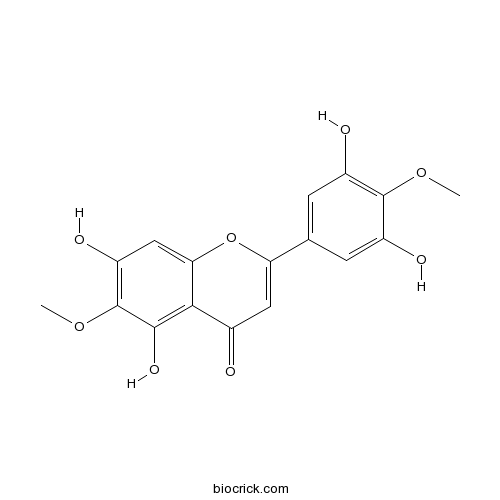3',5,5',7-Tetrahydroxy-4',6-dimethoxyflavoneCAS# 125537-92-0 |

Quality Control & MSDS
3D structure
Package In Stock
Number of papers citing our products

| Cas No. | 125537-92-0 | SDF | Download SDF |
| PubChem ID | 10337658 | Appearance | Yellow powder |
| Formula | C17H14O8 | M.Wt | 346.3 |
| Type of Compound | Flavonoids | Storage | Desiccate at -20°C |
| Solubility | Soluble in Chloroform,Dichloromethane,Ethyl Acetate,DMSO,Acetone,etc. | ||
| Chemical Name | 2-(3,5-dihydroxy-4-methoxyphenyl)-5,7-dihydroxy-6-methoxychromen-4-one | ||
| SMILES | COC1=C(C=C(C=C1O)C2=CC(=O)C3=C(C(=C(C=C3O2)O)OC)O)O | ||
| Standard InChIKey | KPONYCCDEVQZMR-UHFFFAOYSA-N | ||
| Standard InChI | InChI=1S/C17H14O8/c1-23-16-9(19)3-7(4-10(16)20)12-5-8(18)14-13(25-12)6-11(21)17(24-2)15(14)22/h3-6,19-22H,1-2H3 | ||
| General tips | For obtaining a higher solubility , please warm the tube at 37 ℃ and shake it in the ultrasonic bath for a while.Stock solution can be stored below -20℃ for several months. We recommend that you prepare and use the solution on the same day. However, if the test schedule requires, the stock solutions can be prepared in advance, and the stock solution must be sealed and stored below -20℃. In general, the stock solution can be kept for several months. Before use, we recommend that you leave the vial at room temperature for at least an hour before opening it. |
||
| About Packaging | 1. The packaging of the product may be reversed during transportation, cause the high purity compounds to adhere to the neck or cap of the vial.Take the vail out of its packaging and shake gently until the compounds fall to the bottom of the vial. 2. For liquid products, please centrifuge at 500xg to gather the liquid to the bottom of the vial. 3. Try to avoid loss or contamination during the experiment. |
||
| Shipping Condition | Packaging according to customer requirements(5mg, 10mg, 20mg and more). Ship via FedEx, DHL, UPS, EMS or other couriers with RT, or blue ice upon request. | ||
| Description | 1. 5,7,3',5'-Tetrahydroxy-6,4'-dimethoxyflavone exhibits cytotoxic activity against P-388 cell lines, it can inhibit DNA topoisomerase IIα activity, which may be responsible for the observed cytotoxicity. 2. 5,7,3',5'-tetrahydroxy-6,4'-dimethoxyflavone exhibits anti-HIV-1 activity in the anti-syncytium assay using (∆Tat/rev)MC99 virus and 1A2 cell line system, it shows considerably activity against HIV-1 reverse transcriptase. |
| Targets | HIV | Topoisomerase |

3',5,5',7-Tetrahydroxy-4',6-dimethoxyflavone Dilution Calculator

3',5,5',7-Tetrahydroxy-4',6-dimethoxyflavone Molarity Calculator
| 1 mg | 5 mg | 10 mg | 20 mg | 25 mg | |
| 1 mM | 2.8877 mL | 14.4383 mL | 28.8767 mL | 57.7534 mL | 72.1917 mL |
| 5 mM | 0.5775 mL | 2.8877 mL | 5.7753 mL | 11.5507 mL | 14.4383 mL |
| 10 mM | 0.2888 mL | 1.4438 mL | 2.8877 mL | 5.7753 mL | 7.2192 mL |
| 50 mM | 0.0578 mL | 0.2888 mL | 0.5775 mL | 1.1551 mL | 1.4438 mL |
| 100 mM | 0.0289 mL | 0.1444 mL | 0.2888 mL | 0.5775 mL | 0.7219 mL |
| * Note: If you are in the process of experiment, it's necessary to make the dilution ratios of the samples. The dilution data above is only for reference. Normally, it's can get a better solubility within lower of Concentrations. | |||||

Calcutta University

University of Minnesota

University of Maryland School of Medicine

University of Illinois at Chicago

The Ohio State University

University of Zurich

Harvard University

Colorado State University

Auburn University

Yale University

Worcester Polytechnic Institute

Washington State University

Stanford University

University of Leipzig

Universidade da Beira Interior

The Institute of Cancer Research

Heidelberg University

University of Amsterdam

University of Auckland

TsingHua University

The University of Michigan

Miami University

DRURY University

Jilin University

Fudan University

Wuhan University

Sun Yat-sen University

Universite de Paris

Deemed University

Auckland University

The University of Tokyo

Korea University
- Dracorhodin perchlorate
Catalog No.:BCN2628
CAS No.:125536-25-6
- Testosterone phenylpropionate
Catalog No.:BCC9171
CAS No.:1255-49-8
- SR 8278
Catalog No.:BCC6191
CAS No.:1254944-66-5
- Sibutramine hydrochloride monohydrate
Catalog No.:BCC5251
CAS No.:125494-59-9
- Saclofen
Catalog No.:BCC6580
CAS No.:125464-42-8
- LY2874455
Catalog No.:BCC1723
CAS No.:1254473-64-7
- RQ-00203078
Catalog No.:BCC6419
CAS No.:1254205-52-1
- Acetate gossypol
Catalog No.:BCN5354
CAS No.:12542-36-8
- TCN 238
Catalog No.:BCC7901
CAS No.:125404-04-8
- Cedrelone
Catalog No.:BCN6135
CAS No.:1254-85-9
- 6-Acetonyl-N-methyl-dihydrodecarine
Catalog No.:BCN6134
CAS No.:1253740-09-8
- AbK
Catalog No.:BCC8011
CAS No.:1253643-88-7
- LY 233053
Catalog No.:BCC5771
CAS No.:125546-04-5
- PF-4708671
Catalog No.:BCC5031
CAS No.:1255517-76-0
- UNC0638
Catalog No.:BCC1135
CAS No.:1255580-76-7
- MnTMPyP Pentachloride
Catalog No.:BCC6532
CAS No.:125565-45-9
- Rotigotine hydrochloride
Catalog No.:BCC1908
CAS No.:125572-93-2
- [Leu31,Pro34]-Neuropeptide Y (porcine)
Catalog No.:BCC5716
CAS No.:125580-28-1
- TRX818
Catalog No.:BCC6458
CAS No.:1256037-58-7
- AI-10-49
Catalog No.:BCC3973
CAS No.:1256094-72-0
- RuBi-Nicotine
Catalog No.:BCC7793
CAS No.:1256362-30-7
- Ledipasvir
Catalog No.:BCC1696
CAS No.:1256388-51-8
- CH5424802
Catalog No.:BCC3749
CAS No.:1256580-46-7
- Blinin
Catalog No.:BCN8455
CAS No.:125675-09-4
DNA topoisomerase IIalpha inhibitory and anti-HIV-1 flavones from leaves and twigs of Gardenia carinata.[Pubmed:22155186]
Fitoterapia. 2012 Mar;83(2):368-72.
Four new flavones, 5,2'-dihydroxy-7,3',4',5'-tetramethoxyflavone (1), 5,2',5'-trihydroxy-7,3',4'-trimethoxyflavone (2), 5,7,2',5'-tetrahydroxy-6,3',4'-trimethoxyflavone (3) and 5,2',5'-trihydroxy-6,7,3',4'-tetramethoxyflavone (4), along with the known 5,3'-dihydroxy-6,7,4',5'-tetramethoxyflavone (5), 5,7,3',5'-tetrahydroxy-6,4'-dimethoxyflavone (6), syringaldehyde, vanillic acid and scopoletin were isolated from the leaves and twigs of Gardenia carinata (Rubiaceae). Their structures were determined by spectroscopic methods. Flavone 2 exhibited cytotoxic activity against P-388 and MCF-7 cell lines, while 3, 5 and 6 were active only in P-388 cell line. All active compounds were found to inhibit DNA topoisomerase IIalpha activity, which may be responsible for the observed cytotoxicity. Flavones 1-3, 5 and 6 also exhibited anti-HIV-1 activity in the anti-syncytium assay using (Tat/rev)MC99 virus and 1A2 cell line system; 2 was most potent. Only flavones 1 and 6 showed considerably activity against HIV-1 reverse transcriptase.


